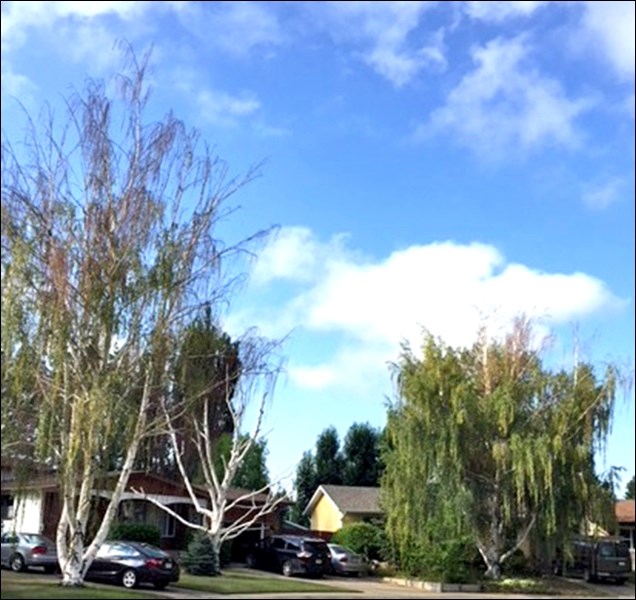Back in the 1970s and ‘80s the City of North Battleford began planting European weeping birch as a street tree in the city. Locally, some people call this tree weeping willow. The tree is native to Europe but hardy for growing zones 2-3 in Canada. That means, as far as cold hardiness goes, it can be grown on the prairies. A growing zone rating does not rate tree suitability for other environmental factors like heat, drought or pests and disease.
The European weeping birch is a fast growing, beautiful tree when it is young and vigorous and a street lined with these trees, when the trees are healthy, is quite an amazing view to see.
For a period of time, when a new city neighbourhood was being lined with street trees, homeowners had a choice of trees and consequently, some tree types were favoured over others and some types were over planted.
Some of the things that were not known at the time were that:
• Fast growing trees generally do not live a long time. These trees can grow to 40to 50 feet in 30 years.
• The lifespan of a European weeping birch varies and is put at somewhere between 30 to 50 years. Growing conditions are responsible for the wide range in life span.
• Tree species diversity in the urban forest is important.
• Birch trees are shallow rooted and therefore are one of the first species to be affected by drought.
• Birch trees thrive in a cool moist soil.
• There are native (naturally occurring) insects on the prairies that infest stressed birch trees.
If the above information were readily available then, like we have now with the Internet, urban foresters at the time would have adjusted the planting plan. There are some blocks in the city that are planted to 100 per cent European weeping birch. Now, this is called a monoculture. What is recommended now is to have a few different species planted on a street so if there is an infestation only one of the species will be affected.
Birch trees have been in big trouble on the prairies for a while. We have had many years of average or below average moisture. Birch trees like to grow is in cool moist soil, with an understory of shrubs, close to water or on north facing slopes. They are not that well suited to being a specimen tree planted in the wide open prairie or front lawn.
As with all trees, when they are subject to environmental stresses from heat or drought or end of lifespan issues, the insects and diseases take advantage of the opportunity and begin to finish the tree off.
The insect that is killing the tops of the birch trees around here, is called the bronze birch borer. The adult borer lays its eggs in a bark crevasse and the larva that hatch, tunnel into where the bark meets the wood and they eat. This disrupts the flow of sap up the tree and the portions of the tree above the tunneling die. You can tell that it is the bronze birch borer because when the adult borer exits the tree it chews a D-shaped hole, about one-eighth inch across, in the branches and trunk. Once you have an infestation there is very little you can do to eliminate the pests.
To help prevent an infestation in your tree you can choose a species of tree at planting time that is more suited to the prairie growing conditions or keep the birch tree mulched and well watered. This means soaking the soil not at the trunk but out as far as the branches spread, at the drip line.
To manage an infestation you can:
• Manage the deadwood. Remove the dead and dying wood below the affected part of the tree at a healthy branch junction.
• Don’t keep the wood in your yard for firewood. That will only keep more borers in close proximity to your tree.
• Dead birch branches that are more than one season old can break in the wind and become dangerous to people and things.
• Keep the tree well watered. This means soaking the soil, not at the trunk but out as far as the branches spread, at the drip line
• A three inch thick wood chip mulch around the tree (but not right touching the trunk) will help to keep the root zone cool and moist
The bronze birch borer is rampant on the prairies. Prairie towns and cities are going to look a lot different without the European weeping birch.
Here’s the good news. The Western Nursery Growers Group is an association of Canadian nursery growers that have tested all kinds of trees (including birch varieties and species) in various locations on the prairies. They have developed a list of recommended trees for the prairie growing conditions. Check out www.prairietrees.ca to see what the nursery growers are recommending for your prairie planting.



